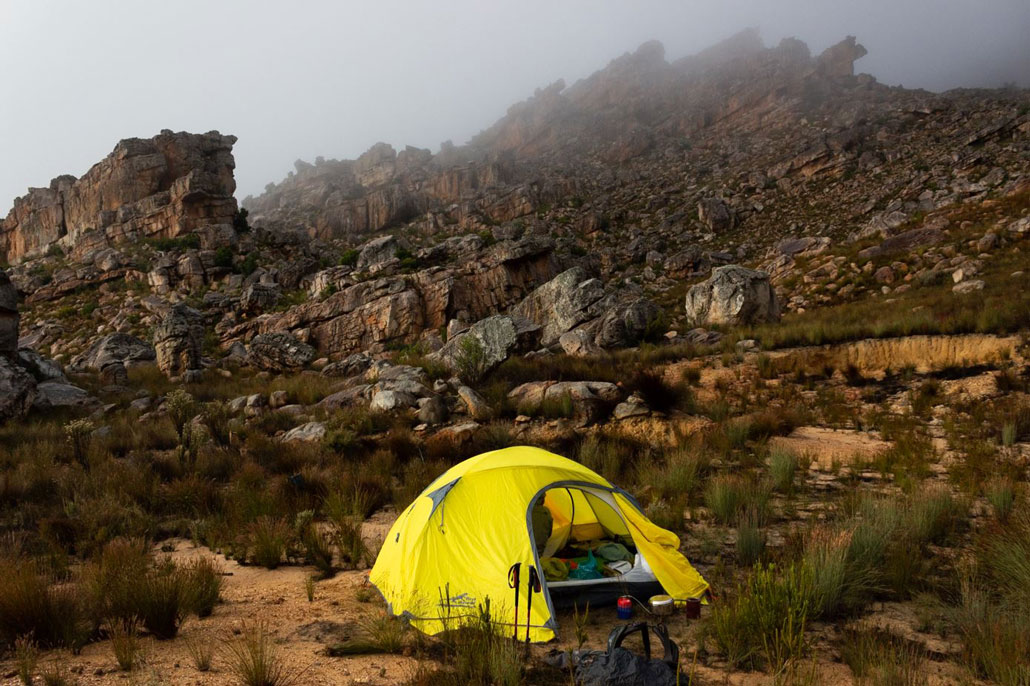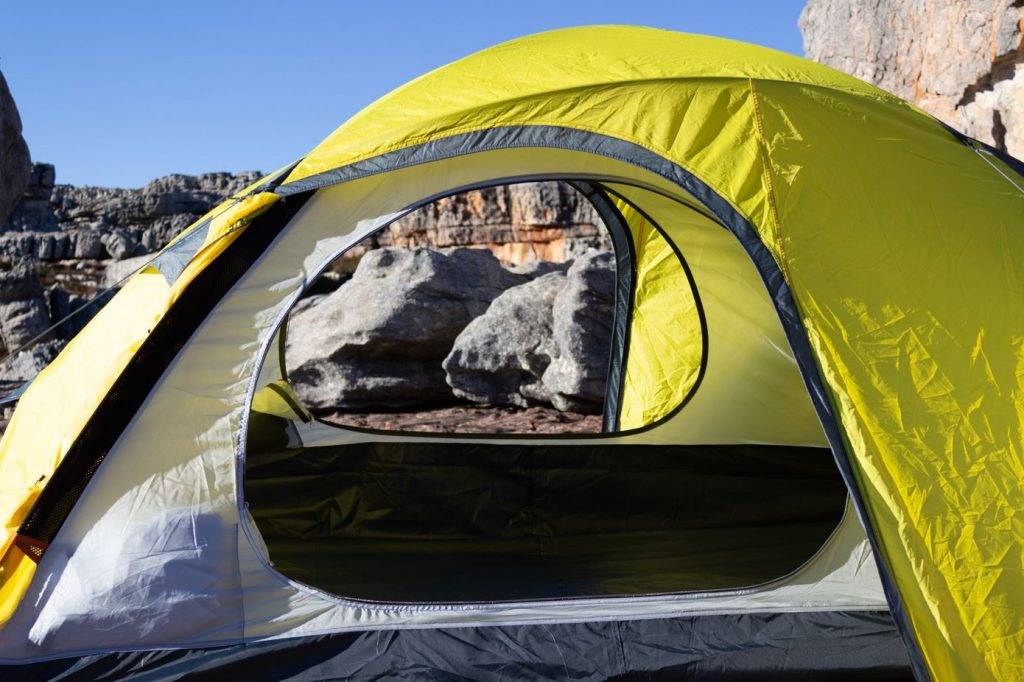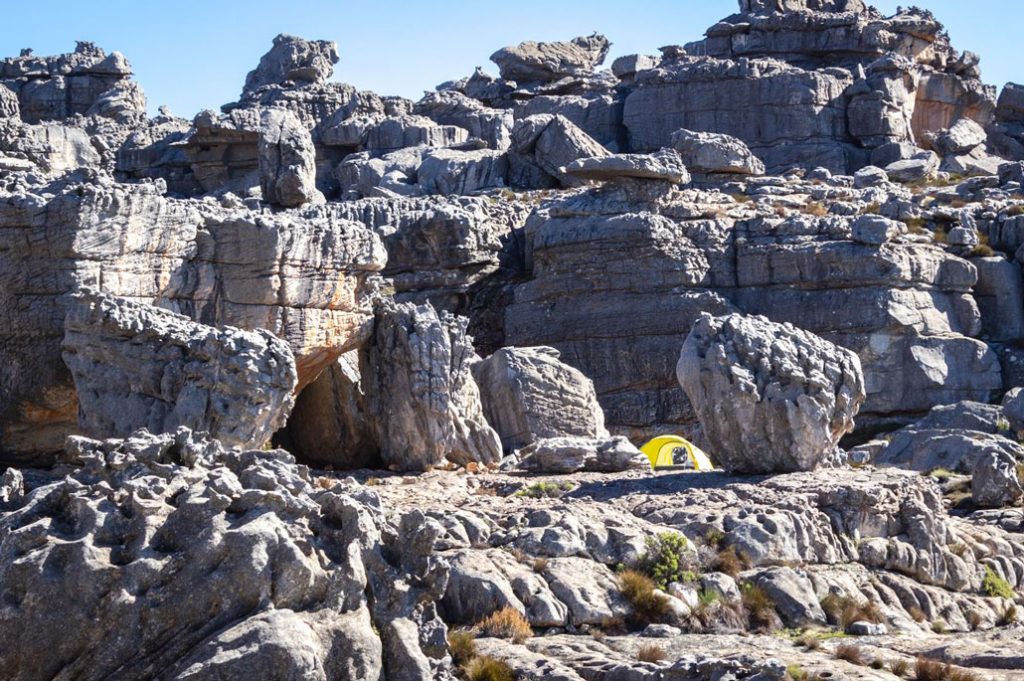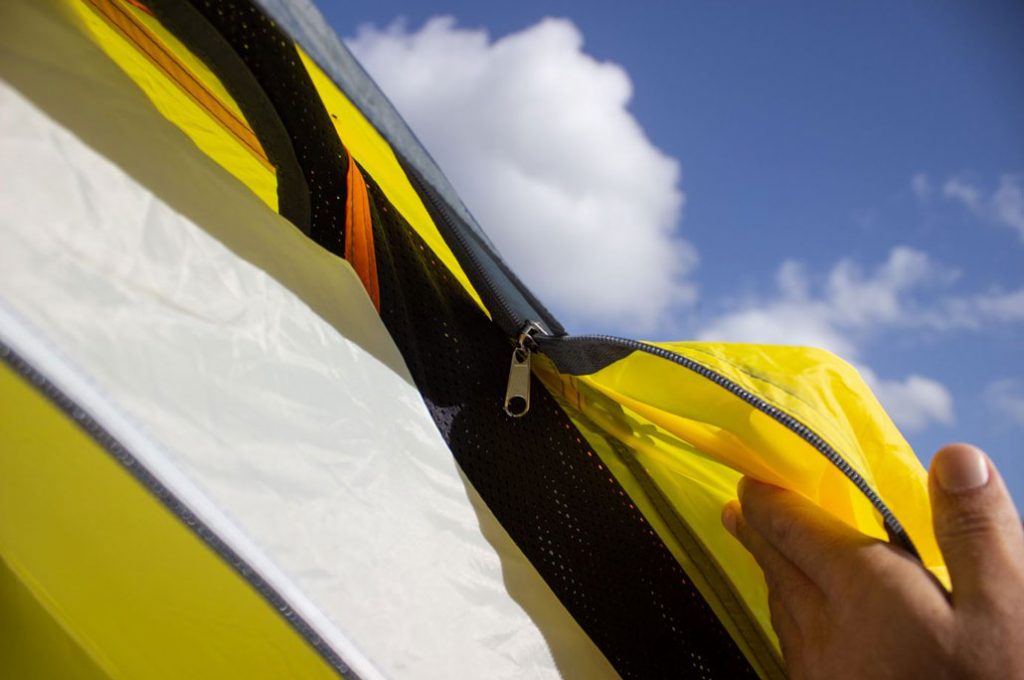
The First Ascent Peak is an extremely stable tent that can handle very strong winds. I had it pitched in near gale force winds where the rain was hitting the fly sheet so hard, it was deafening. The tent showed no signs of budging, with minimal flex in the main structure and only some movement along door panels. At R3499 (at time of writing), it offers amazing value for money for a proper 4-season tent.
Quick Specs
Size: Will work as a 3-person tent if necessary, but is very comfortable as a 2-person tent
Weight: 4067g (without stuff sack, i.e. trail weight)
Waterproof rating: Flysheet: 5000mm HH; Groundsheet: 5000mm HH
Structure: 4 poles; 9 intersections
Price: R3499 (at time of writing)

Weight
Advertised as 4.35kg, I found that by removing the stuff sack that the tent comes in, the total weight drops to 4067g. Definitely not light, but not ridiculous for a proper 4-season tent – when those high mountain winds start “nuking”, you’re going to be glad you carried that extra 500g of tent.
Fly sheet: 1170g
Tent (inner): 1600g
Poles: 1117g
Pegs: 180g
Ease of Pitching
The poles run through sleeves, which adds a lot of stability to the tent, but it’s definitely easier to set up if there’s another person to help guide the poles through the sleeves. When pitching the tent in wind, it helps pegging the corners of the tent down first, before inserting the poles.
Once the poles have been run through the sleeves and the inner tent is up, the rest is straight forward. The fly sheet attaches to the inner tent by means of clips that can be tensioned, and in high winds, the pegs can secured to the tent with loops of cord. The tent is then further secured by means of six guy lines.

Inside the Tent
As mentioned in the Quick Specs, width-wise this tent is a tight fit for 3 people, but very comfortable for 2, with lots of room to move and space to store essentials inside the tent. It has the usual mesh storage pouches at the top and bottom end of the tent.
On the “ceiling”, there is a little suspended, mesh “attic” which can be used to store light items off the floor and makes for a great spot to hang a lamp and light up the whole tent.

The sleeping area is surprisingly long (2.5m). I am 1.86m tall and I had loads space at my feet to store extra clothes and food – definitely a key feature for the taller hikers.

Ventilation
There are four vents in the fly sheet – 2 on either end of the tent – that can be opened and closed, depending on preference. The vents, combined with the half-height mesh panels in the doors, do a great job at ventilating the tent and keeping condensation to a minimum.


Entrances and Vestibules
The First Ascent Peak has entrances and vestibules on either side of the tent, which makes for easy entry and exit without disturbing your “roommate” too much, unless you’re three, in which case the middle person will have to climb over someone to get out.

It features a similar inner-door design to the Vango Halo 300. It has O-shaped doors which make for easy, one-handed operation and can get stored away in a mesh pocket just next to where the zippers end (as opposed to rolling it up and securing it with toggles).

The vestibules aren’t really big enough to sit under and cook if the weather’s bad, but it’s perfect for storing your shoes and backpack out of the rain. The fact that there’s a vestibule on either side makes it even easier to keep things organised, as each hiker (if you’re only two) has direct access to their own bag.

I did pick up on one little design flaw: The vestibule’s zipper ends right next to one of the pole sleeves. If the fly sheet is slightly off-centre, the vestibule zipper tends sit on top of the pole sleeve. When it rains and you have strong enough winds, a little bit of water pushes up underneath zipper cover – this is normal and happens with almost all tents. What is interesting and undesirable, is that the water that gets pushed onto the zipper ends up seeping through onto the pole sleeve. The water gets absorbed by the sleeve and after a few hours, ends up slowly seeping into the corner of the tent. This can be overcome by somehow sealing the last 10cm of the zipper to ensure no water makes it onto the pole sleeve, but ultimately it will need to be revised in the next model. The chances of this happening are pretty slim, so you might never experience it, but I felt it worth mentioning.

Overall Construction
This tent is bombproof! The 4 poles intersect 9 times and the fact that the they run through sleeves, as opposed to clips, results in a very sturdy structure with even force distribution throughout the tent body. With the guy lines secured, this tent isn’t going anywhere.

The attachment points for the poles and pegs are all reinforced.

Both the flysheet and the floor have a 5000mm HH waterproof rating and the polyester has a very robust feel which should stand up to years of abuse.
The tent was supplied for review by First Ascent and can be purchased directly from them on their website.





was really impressed with this tent. very sturdy, visible; ideal for 2 sizable fellows (with no tall-man problems) or functional as a 3-man tent; and proudly south african. great value for money.
This is such a comprehensive review. Great that you got to test it in the elements, and that it stood up to the test!
Please can you advise me which tent you would go for? Between the The First Ascent Peak , 4 season or the Vango halo 300 tent?
Also what would be your reasoning? Would you recommend any other tent?
Short answer: Vango Halo 300. It’s easier to pitch, slightly lighter, better vestibule design and the fly-first pitching is great in the rain.
If you’re specifically looking for a 3-person tent that can handle extreme weather, I’d recommend the First Ascent Eclipse over the Peak. More affordable, more spacious and can handle the same amount of weather.
The Vango Helvellyn 200 or 300 is also a great option.
Hi Arno, Thank you so much for the above advise.
Hi Arno how much headroom is there for a tall person?
Plenty. For two people, it is super roomy.
Hi Arno,
Does the Peak tent also allow you to cook inside like the Helio tent?
Not sure if there’s a specific feature on the Helio you’re referring to, but the Peak definitely has enough room under the vestibule to cook in.